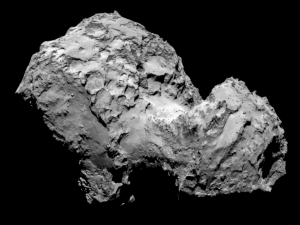
An unnamed European mission engineer said early data from the Philae probe on Comet 67P tells us about “who we are.” And the answer looks like this.
European scientists behind the Rosetta mission to Comet 67P had hoped that by landing a probe on the comet surface they might determine its essential properties, and be able to deduce answers to larger questions about the universe, the Milky Way galaxy, our solar system, planet Earth and about humanity itself.
Early results from Philae, the European Space Agency (ESA) probe which touched down Wednesday, have exceeded expectations, according to one source.
“The telemetry and photographs tell us a great deal,” said an unnamed Rosetta mission engineer. “They tell us not just about the comet, but about the fundamental essence of the universe — about who we are.”
“Initial data indicates that we are cold, dark, lumpy and adrift in the cosmos,” said the engineer, who has devoted more than a decade to the project, yet whose name remains unknown to most of humanity despite the glorious, ennobling nature of the mission, and likelihood that this is the very zenith of his short lifespan.
“We’re looping endlessly around the sun for no apparent reason,” he added. “We’re harsh, stony, dirty and bleak — tumbling, enduring desolation, and periodically spewing our waste into the vast vacuum of space where it dissipates without a trace. That’s who we are, if you really want to know.”
The European engineer added that he’s not sure it was necessary to spend nearly $2 billion and two decades to determine this, and that he should have suspected as much after his first philosophy class at university.

 November 13th, 2014
November 13th, 2014  Scott Ott
Scott Ott 
 Posted in
Posted in  Tags:
Tags: 



